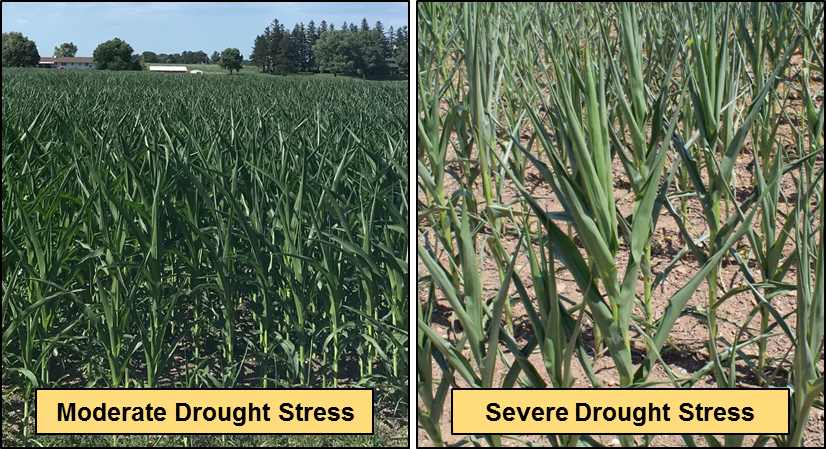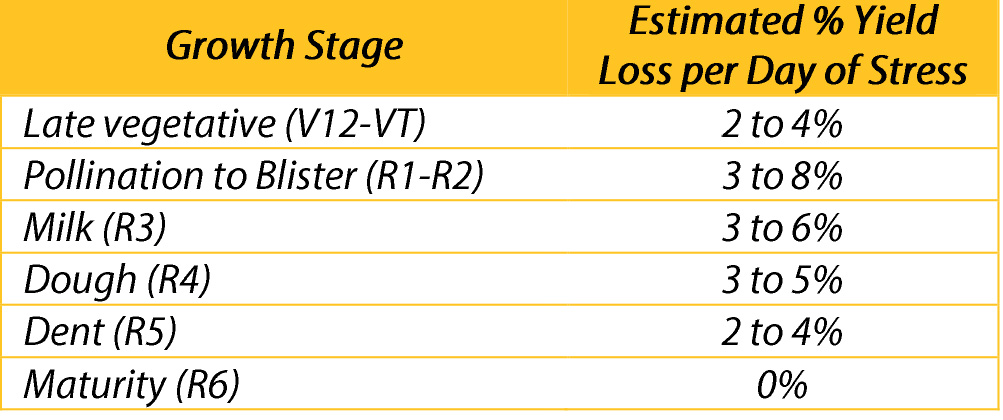Background
The Midwest corn crop typically pollinates during July. In any particular field, this process takes about 5-8 days. When corn is planted within the typical window (late April to mid May), most corn will pollinate during the first half of July, so it’s not unusual for pollination to occur during periods of hot temperatures. The ability of a crop to tolerate high heat during pollination largely depends on the amount of soil moisture. This issue of Wyffels Between the Rows® will review the effects of heat and drought on corn during pollination and early grainfill.
Leaf Rolling
When the air temperature exceeds 90°F and the soil moisture profile is not at full capacity, plants will often roll in the heat of the day to conserve water and protect leaf tissue from heat damage. Plants that are severely stressed by heat and drought will roll in the morning and stay rolled at dusk and have a grayish water-soaked plant appearance.
Fields that have soil compaction, or with less productive soil types, will often roll first. Later planted fields will also roll sooner than earlier planted fields because the root systems are smaller and shallower. It is estimated that yield is reduced by 1% for every 12 hours of leaf rolling.

Pollination
High temperature in itself will not always be detrimental to completing pollination and seed set, but coupled with drought stress, the combination can significantly reduce yield. Temperatures above 95° F coupled with dry conditions can reduce the viability or longevity of pollen. Under extreme temperatures and drought, “tassel blast” can occur when moisture cannot be transferred to the upper part of the plant as fast as it is lost. Since most pollen sheds in the morning, the impact temperature has on pollen is usually not a major factor in yield reduction.
Silks have high water content, so when soil moisture is limited silk growth is slowed and emerged silks may not be receptive to pollen. Hot weather can speed up pollen shed and dry weather can slow silk growth. Extreme heat and drought can cause pollen shed and silk emergence to be out of sync, referred to as a missed nick. The result of a missed nick is incomplete pollination with scattered seed set on ears, particularly on the top half of the ear, or blank ears under severe conditions.
Severe drought stress prior to pollination can reduce ear length and reduce the number of potential kernels. However, heat and drought stress that occurs during and two weeks after pollination will have a large impact on final yield. The amount of yield reduction is dependent on severity of drought, soil moisture, field conditions and hybrid.
Grain fill
Heat and drought stress during early grain fill can cause corn plants to abort kernels all the way up until the dough stage. After dough stage, yield is primarily lost by reduced kernel size and weight. The impact is amplified on plants that have lost green leaf tissue.
High nighttime temperatures are most detrimental during grain fill. Corn plants increase respiration rates and use sugars needed for kernel fill during hot summer nights with temperatures in the upper 70s or 80s. It’s no coincidence that record-breaking yields often occur in years with cooler July and August temperatures.
The data displayed in Table 1 below shows potential yield reductions due to stress at different growth stages. The table clearly shows the impact of the timing of stress on potential yield loss, with the greatest potential yield reduction occurring at pollination and immediately following.

Management
If you don’t have irrigation, there unfortunately aren’t many management practices you can turn to that will prevent yield loss during drought. Having a healthy crop up until this point in the growing season is the best way to withstand weather patterns like this.
Corn is most vulnerable to heat stress during pollination and the two weeks following. Taking note of crop stage and conditions now can help you better understand yield results this fall.
